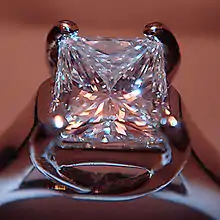Cut (gems)
A gemstone desired to be used in jewelry is cut depending on the size and shape of the rough stone, as well as the desired piece of jewelry to be made. As a general rule, a cut gemstone will reduce the mass (in carats) by about 50%.[1]

A decorative glass crystal about 4 cm (1.6 in) in diameter, having a facet cut often applied for gemstones. At some positions, coloured light (see rainbow colouring) can be regarded caused by the intended optical prism effect of the cut.
Among the several techniques used to work with gemstones are sawing, grinding, sanding, lapping, polishing, grilling, and tumbling. The diamond cut planning stage is a complex process that requires the cutter to work with unique rough stones. Very often, the location of the inclusions in a rough stone will determine the type of shape to which a diamond may be cut. For economic reasons, most diamonds are cut to retain weight instead of maximizing brilliance.[2]
Types

Cut emeralds

Princess cut diamond set in a ring
A list of cuts:
- Antwerp rose cut
- Asscher cut
- Baguette cut
- Barion cut
- Brilliant cut
- Briolette
- Cabochon
- Calla Cut
- Ceylon cut[3]
- Cushion or old mine cut
- Double Dutch rose cut
- Emerald cut
- Flanders cut
- French cut
- Heart brilliant
- India cut
- King brilliant
- Kite brilliant
- Line-Cut
- Lozenge cut
- Magna brilliant
- Marquise or navette cut
- Mogul cut
- Obus cut
- Oval brilliant
- Pear or drop brilliant
- Pendeloque cut
- Princess cut
- Radiant cut
- Rose or rosette cut
- Round brilliant
- Single or eight cut
- Square emerald
- Star brilliant
- Step cut
- Transitional cut
- Trapezoid or trapeze cut
- Trilliant cut, a.k.a. trillian or triangle cut
- Whirl cut
See also
References
- Cowing, Michael (October 2000). "Diamond Brilliance: theories, measurement and judgement". Journal of Gemmology. 27 (4): 209–227. doi:10.15506/JoG.2000.27.4.209. Archived from the original on 2004-12-16.
- "Why Aren't All Diamonds Cut to Ideal Proportions". Online Diamond Buying Guide. Retrieved 2011-01-07.
- "Ceylon cut". Gemmy Zone. Retrieved 25 February 2023.
Further reading
- Warren, Larter (1936). The Line-Cut Diamond, pp. 19–20. Gemological Institute of America, USA, Vol. 2, No. 2 (Summer 1936)
- Shipley, Robert M. (1936). Gemological Glossary, pp. 7. Gemological Institute of America, USA, Vol. 2, No. 4 (Winter 1936)
External links
 Media related to Gem cutting at Wikimedia Commons
Media related to Gem cutting at Wikimedia Commons
This article is issued from Wikipedia. The text is licensed under Creative Commons - Attribution - Sharealike. Additional terms may apply for the media files.